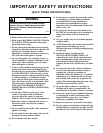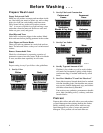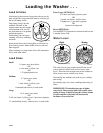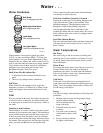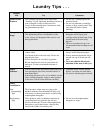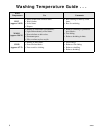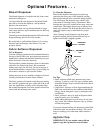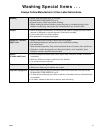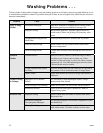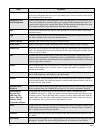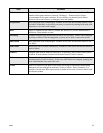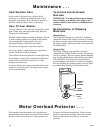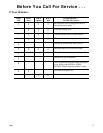
10
38839
Special Care . . .
Starching
Starching adds crispness and body to fabrics, enhances
soil resistance, and makes ironing easier. There are
several types of starches. Carefully follow label
directions for spray or hand starching or starching in
the washer.
Knits
A variety of knits are used for many types of clothing
and household furnishings. Many knits are machine
washable, some are hand washable, and some must be
dry-cleaned. When buying, make sure the garment has
a care label with care instructions. These directions
must be followed. Some knits are stretched during their
manufacture and may shrink or relax when exposed to
water.
Cotton Knits
Unless the label indicates that it is preshrunk, cotton
knits will probably shrink to some degree. Overdrying
contributes to shrinkage of cotton knits. Wash water
should be hot or warm suitable for color and soil. The
rinse water should be cold.
Rayon Knits
Rayon stretches and shrinks easily. Treat as a delicate
fabric and wash gently.
Synthetic Fiber Knits
Knits made from synthetic fibers or blends containing
a high percentage of synthetics will generally keep
their shape. When buying, make sure the trimmings
(including belts) are machine washable, seams are not
puckered, and zippers and trimmings are well fastened.
Knits of Man-Made Fibers
In general, follow the rules for permanent press fabrics
as they tend to have the same characteristics. Set
machine to PERMANENT PRESS/KNITS cycle. Set
the wash water warm, or suitable for color and soil.
Rinse water should be cold. Do not wash with lint-
shedding fabrics. Separate items for color, washing
whites separately.
Sweaters of Man-Made Fibers
Follow directions for comparable knits. Button
sweaters and turn inside out. The ribbon behind the
buttons and button holes may shrink. Stretch to shape
after washing. Orlon sweaters may stretch. Avoid
pulling them when wet. Dryer dry.
Wool Sweaters
Loosely knit or delicately constructed sweaters will
need delicate care. Hand wash. Measure garment
before and after washing. Squeeze gently through the
water with little motion. Rinse thoroughly. Block to
shape and dry flat.
For sweaters labeled “machine washable”, follow
manufacturer’s directions. Dry flat. Excess agitation
and excess tumbling are the main causes of wool
shrinkage.
Wool Knits
Dry-clean wool knits unless labeled machine washable.
Follow manufacturer’s directions.
Permanent Press
Permanent or durable press garments and household
items will usually not need pressing when washed and
dried properly. However, some will be more wrinkle
resistant than others.
The care needed for permanent press is a little different
than for cottons. Permanent press garments will soften
or become pliable when heated. This softening when it
is in warm or hot wash water will allow wear wrinkles
to be removed. It will also cause the fabric to wrinkle if
it is crushed, squeezed or spun when hot.
How To Wash Permanent Press
1. Wash often. Permanent press clothes tend to look
clean even when they should be washed.
2. Sort loads correctly, refer to page 6.
3. Do not wash with lint-shedding loads. Permanent
press attracts lint in the wash water.
4. Pre-treat grease stains and oily areas. This is
especially important for shirt collars and cuffs. Rub
liquid detergent or a paste of detergent into the
area.
5. Use the PERMANENT PRESS/KNITS cycle, hot
or warm water, cold rinse, and sufficient detergent.
6. Use fabric softener in the rinse water. This will
reduce the static electricity which attracts lint and
makes garments cling.
To Dry Permanent Press
For best results, permanent press should be dryer dried.
See garment care labels. Ironing may be necessary. Use
low heat setting on iron or steam setting on a steam
iron.



